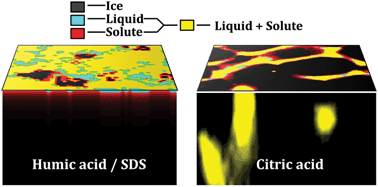Emerging investigator series: spatial distribution of dissolved organic matter in ice and at air–ice interfaces†
Abstract
Dissolved organic matter (DOM) is a common solute in snow and ice at Earth's surface. Its effects on reaction kinetics in ice and at air–ice interfaces can be large, but are currently difficult to quantify. We used Raman microscopy to characterize the surface and bulk of frozen aqueous solutions containing humic acid, sodium dodecyl sulfate (SDS), and citric acid at a range of concentrations and temperatures. The surface-active species (humic acid and SDS) were distributed differently than citric acid. Humic acid and SDS are almost completely excluded to the air–ice interface during freezing, where they form a film that coats the surface nearly completely. A liquid layer that coats the majority of the surface was observed at all humic acid and SDS concentrations. Citric acid, which is smaller and less surface active, is excluded to liquid channels at the air–ice interface and within the ice bulk, as has previously been reported for ionic solutes such as sodium chloride. Incomplete surface wetting was observed at all citric acid concentrations and at all temperatures (up to −5 °C). Citric acid appears to be solvated in frozen samples, but SDS and humic acid do not. These results will improve our understanding of the effects of organic solutes on environmental and atmospheric chemistry within ice and at air–ice interfaces.

- This article is part of the themed collections: Emerging Investigator Series and ESPI Cover Art 2019


 Please wait while we load your content...
Please wait while we load your content...